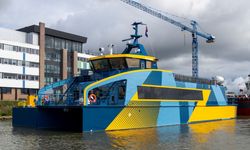This CTV, designed for passenger and cargo transport to offshore wind farms, incorporates an eco-friendly hybrid electric propulsion system. Construction of the vessel began in September 2024 at a Korean shipyard, with its launch planned for next year.
While CTVs are commonly used in Europe for offshore wind farm construction and maintenance, their reliance on diesel engines has raised concerns about carbon emissions. The newly approved CTV addresses these concerns by using a hybrid system powered by batteries, offering reduced emissions and fuel cost savings while supporting safer operations at wind farms.
The vessel features key components such as a hybrid system and an energy storage system (ESS) from Hanwha Aerospace, Linear Jet propulsion units, power conversion devices, and an integrated Power & Energy Management System (PEMS). Generators are supplied by YusinHR.
Hanwha Aerospace’s ESS uses an immersion method for its lithium-ion batteries, improving insulation, cooling, and fire safety. The Linear Jet propulsion system, provided by YusinHR, offers high efficiency with a top speed of 25 knots and is expected to impact the Korean propulsion market positively.
According to MARCON, the hybrid CTV will reduce operating time by 34% and cut carbon emissions by 70% compared to conventional diesel-powered vessels.
KR reviewed the design for safety and compliance with both domestic and international regulations. KIM Daeheon, Executive Vice President of KR’s R&D Division, emphasized the significance of applying this eco-friendly technology to a CTV and affirmed KR’s ongoing support for the project.





